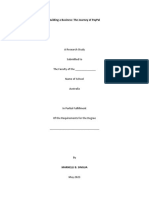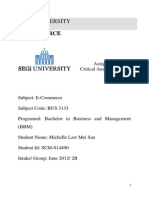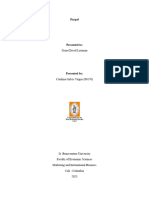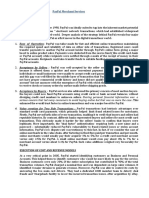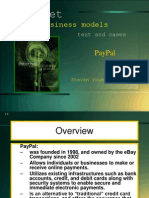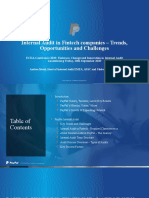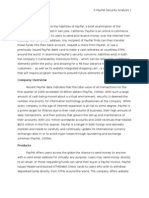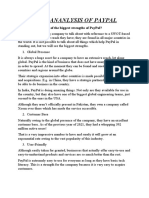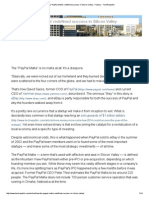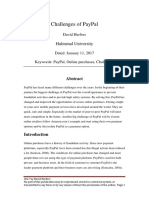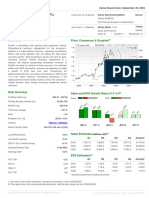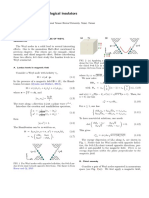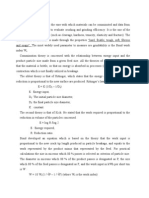FINTECH’S HIDDEN HAND: HOW PAYPAL RESHAPED THE FINANCIAL
WORLD
Dr. S. Prasanna Kumar 1, Jayasurya K 2
Assistant Professor 1, Dept of Commerce, Loyola College, Chennai.
Student 2, Dept of Commerce, Loyola College, Chennai.
ABSTRACT
This paper delves into the transformative journey of PayPal, tracing its roots from a nascent
startup to a globally dominant fintech powerhouse. Emerging in the late 1990s, PayPal was a
revolutionary force that disrupted traditional banking paradigms, introducing the world to
seamless, secure digital transactions. Beyond its technical prowess, PayPal catalyzed a
cultural and economic shift by democratizing financial access, enabling global e-commerce,
and giving rise to the "PayPal Mafia"—a group of entrepreneurial alumni who have since
shaped industries far beyond fintech. This article offers an in-depth examination of PayPal's
innovative strategies, the challenges it overcame, its integration with eBay, and its broader
implications for the financial world. By understanding PayPal’s trajectory, readers gain
insights into the mechanics of fintech innovation, the power of strategic pivots, and the
enduring impact of a company that redefined the future of money.
Keywords: Digital Payments, Fintech, E-commerce, PayPal Mafia, Financial Innovation
INTRODUCTION
The financial world at the close of the 20th century was steeped in inefficiencies, constrained
by legacy systems and traditional banking processes. Amid this backdrop, PayPal emerged as
a revolutionary force, leveraging technology to redefine how money moves in a digitally
connected world. Its story begins in December 1998, when three ambitious
entrepreneurs—Max Levchin, Peter Thiel, and Luke Nosek—came together with a vision to
create encryption software for handheld devices like the PalmPilot. Initially branded as
Confinity, the company’s trajectory changed dramatically when it pivoted toward digital
payments, sensing an untapped potential in facilitating secure, seamless online transactions.
The original concept was simple yet groundbreaking: enable users to send and receive money
via email. This innovation came at a time when online commerce was gaining traction but
lacked an efficient payment solution. Traditional methods like checks and wire transfers were
�slow and cumbersome, and credit card processing systems were not yet optimized for digital
platforms. PayPal’s email-based payment system bridged this gap, offering speed, security,
and convenience. Users could link their PayPal accounts to their bank accounts or credit
cards, enabling transactions with just an email address. It was an elegant solution to a
complex problem, and its potential quickly caught the attention of early adopters.
However, the road to success was anything but smooth. PayPal’s founders faced numerous
challenges, including fierce competition, rampant fraud, and regulatory scrutiny. Early
competitors like Billpoint and eMoneyMail, along with traditional banks, sought to emulate
PayPal’s model or outmaneuver it. Meanwhile, fraudsters exploited the platform’s nascent
security systems, prompting PayPal to develop cutting-edge fraud detection algorithms that
would later set industry standards.
One of the pivotal moments in PayPal’s history was its merger with X.com, an online
banking company founded by Elon Musk in 1999. This merger brought together two
visionary teams and consolidated resources, allowing the unified company to dominate the
digital payment landscape. Musk’s vision of creating a comprehensive online financial
platform complemented PayPal’s focus on payments, leading to rapid innovation and growth.
Despite internal conflicts and leadership changes, the merger proved to be a strategic
masterstroke that solidified PayPal’s market position.
PayPal’s integration with eBay was another transformative milestone. In the early 2000s,
eBay’s auction platform was flourishing, but its users faced significant challenges in
completing transactions. PayPal’s secure and efficient payment system became the preferred
solution for millions of eBay buyers and sellers, creating a symbiotic relationship that drove
exponential growth for both companies. By the time eBay acquired PayPal in 2002 for $1.5
billion, PayPal had become the default payment method for online auctions, boasting millions
of users worldwide.
Beyond its technological and strategic achievements, PayPal’s cultural impact cannot be
overstated. The company fostered a unique environment that encouraged risk-taking,
innovation, and resilience. This culture gave rise to the "PayPal Mafia," a network of former
employees who went on to create and fund some of the most influential companies of the 21st
century, including Tesla, SpaceX, LinkedIn, YouTube, and Palantir. Their collective impact
�has shaped industries far beyond fintech, cementing PayPal’s legacy as a breeding ground for
entrepreneurial talent.
In summary, PayPal’s story is one of audacity and adaptability. From its humble beginnings
as a PalmPilot encryption software company to its transformation into a fintech juggernaut,
PayPal redefined the financial landscape, setting the stage for the digital economy we know
today. Its innovations in online payments, security, and user experience continue to influence
the industry, making it a case study in leveraging technology to solve real-world problems
and achieve global scale.
PROBLEM STATEMENT
As the financial world rapidly embraced digital transformation, traditional payment methods
became glaringly inefficient, failing to meet the needs of an increasingly global and
interconnected economy. Checks, wire transfers, and cash transactions, long the cornerstones
of financial exchanges, were plagued by delays, high costs, and security vulnerabilities.
These limitations were further exacerbated by the explosive growth of e-commerce platforms
like eBay, where buyers and sellers faced significant hurdles in completing transactions. The
absence of a reliable, seamless payment system eroded user trust, hindering the potential of
online marketplaces to thrive.
Fraud and security risks compounded these challenges, creating a precarious environment for
digital transactions. The lack of robust systems to detect and mitigate fraud deterred
consumers from embracing online payments, while businesses bore the brunt of financial
losses and reputational damage. Furthermore, navigating the labyrinth of global financial
regulations posed additional barriers, particularly for platforms striving to operate across
multiple jurisdictions.
In this fragmented landscape, the entry of PayPal was a game-changer. By addressing critical
pain points with its email-based payment system, PayPal redefined the possibilities of
financial connectivity. Its innovative approach bridged the gap between consumers and
businesses, offering a solution that was not only fast and secure but also universally
accessible. The company’s ability to tackle fraud head-on and ensure compliance with
evolving regulations further solidified its reputation as a trusted payment facilitator.
�This research aims to delve into how PayPal identified and addressed these systemic
inefficiencies, transforming itself into a catalyst for change in the global financial ecosystem.
By analyzing PayPal’s strategies, this study seeks to uncover the enduring implications of its
innovations and how they continue to shape the fintech landscape today.
REVIEW OF LITERATURE
The journey of PayPal has been a focal point in numerous studies, business narratives, and
fintech analyses. Eric M. Jackson’s “The PayPal Wars” provides a detailed insider
perspective on the company’s early years, emphasizing its fierce battles with competitors and
regulators. Peter Thiel’s “Zero to One” explores the entrepreneurial mindset and cultural
ethos that propelled PayPal’s success. Jimmy Soni’s “The Founders” delves into the
interpersonal dynamics and strategic decisions that shaped PayPal’s rise. Academic works
have also examined PayPal’s contributions to fraud prevention and its influence on digital
payment security standards, further cementing its role as a fintech pioneer.
RESEARCH GAP
While there is extensive documentation of PayPal’s origins and early achievements, limited
research explores its transformative impact on emerging markets, its strategies for tackling
regulatory challenges, and its influence on the global financial technology landscape. This
article aims to fill these gaps by providing a comprehensive analysis of PayPal’s journey and
its enduring legacy.
RESEARCH OBJECTIVES
This research focuses on several pivotal objectives to examine PayPal’s transformative
journey in fintech. Firstly, it aims to explore PayPal’s pioneering strategies that have set
benchmarks for innovation and adaptability in the fintech sector. By evaluating its early
initiatives, this study uncovers the methodologies that allowed PayPal to navigate competitive
and technological challenges effectively, establishing itself as a leader.
Another critical objective is to analyze PayPal’s competitive landscape and its responses to
numerous rivals and regulatory hurdles. Understanding these strategies provides a window
into how PayPal maintained resilience and adaptability amidst market pressures, offering
broader lessons for fintech enterprises facing similar challenges today.
�The study also delves into the influence of the PayPal Mafia, a group of former employees
who have significantly shaped global entrepreneurship. By examining their contributions to
diverse industries, this research highlights PayPal’s cultural and professional impact as a
crucible for fostering talent and innovation.
Further, the research investigates PayPal’s strategies in navigating complex regulatory
frameworks and compliance issues. This includes understanding how the company overcame
these challenges to achieve global scalability. The insights drawn from this analysis can offer
valuable guidance for other fintech companies aiming to expand internationally.
Finally, this study evaluates PayPal’s lasting influence on digital economies. From facilitating
cross-border payments to advancing the adoption of digital wallets, PayPal has played a
pivotal role in shaping modern financial ecosystems. This research considers the company’s
ongoing contributions to the digital economy, particularly as fintech continues to evolve, and
explores its potential trajectory in future technological landscapes.
RESEARCH METHODOLOGY
This study adopts a mixed-methods approach, relying primarily on secondary data from
books, articles, and reliable internet sources. Archival data, case studies, and thematic
evaluations of PayPal’s technological innovations and business strategies are key components
of this research. By analyzing existing literature and documented records, this study aims to
draw comprehensive insights into PayPal's contributions to the fintech ecosystem.
RESULTS & DISCUSSION
1. Early Innovations and Strategic Shifts: PayPal’s initial foray into digital payments began
with a PalmPilot-based encryption solution that failed to gain traction. Recognizing the
broader need for a seamless payment solution, PayPal pivoted to email-based payments. This
strategic shift demonstrated PayPal’s innovative mindset and its ability to adapt to emerging
market demands, paving the way for a universal solution that eliminated geographical and
operational barriers. The success of this pivot underlined a larger truth in the fintech
ecosystem: adaptability and foresight are key to addressing unmet financial needs.
2. Integration with eBay: The Turning Point PayPal’s collaboration with eBay proved to be a
transformative milestone. At its peak, eBay accounted for over 70% of PayPal’s transactions.
�By solving the payment trust issue on eBay, PayPal enabled secure exchanges between
buyers and sellers, which dramatically increased e-commerce growth. This partnership
created a network effect, where each new PayPal user further incentivized others to adopt the
platform. The resulting exponential growth elevated PayPal from a niche service to a
mainstream payment system and solidified its market dominance.
3. Fraud Detection and Regulatory Leadership: One of the defining challenges of PayPal’s
early years was the prevalence of fraud. To counter this, PayPal invested heavily in
developing state-of-the-art fraud detection algorithms. These systems not only protected users
but also set a benchmark for the entire industry. Furthermore, PayPal’s proactive approach to
regulatory compliance ensured that it could operate across multiple jurisdictions with
minimal friction. This dual emphasis on security and compliance became a competitive
advantage, allowing PayPal to gain user trust and expand globally.
4. The PayPal Mafia and Entrepreneurial Ripple Effects:
Source: Google
The cultural and professional ethos within PayPal fostered a generation of visionary
entrepreneurs. The “PayPal Mafia,” comprising notable figures such as Elon Musk, Reid
Hoffman, and Peter Thiel, went on to disrupt industries ranging from transportation (Tesla) to
social networking (LinkedIn). This ripple effect extended PayPal’s influence beyond fintech,
as the values of innovation, speed, and risk-taking became hallmarks of Silicon Valley
startups.
�5. The Future: Will Banks Keep Up? As fintech continues to evolve, traditional banks face
unprecedented disruption. Companies like PayPal, along with emerging players such as
Stripe and Square, are offering services that were once the exclusive domain of
banks—lending, cross-border payments, and wealth management. PayPal’s recent foray into
cryptocurrency and its integration of AI-driven financial tools further illustrates the
narrowing gap between fintechs and banks. If traditional banks fail to innovate and adapt to
these disruptions, they risk losing their relevance in a landscape increasingly dominated by
agile, tech-driven solutions. Experts predict that within the next decade, the lines between
banks and fintechs will blur, potentially leading to a seismic shift in how financial services
are delivered globally.
DATA ON FINTECH GROWTH AND BANK DISRUPTIONS
The table below highlights the rise of fintech companies globally and the disruption they have
caused to traditional banks:
Year Approximate No of Fintech Companies Approximate No of Banks
Globally Influenced
2015 12,500 100
2016 14,000 200
2017 16,000 300
2018 18,000 400
2019 21,000 500
2020 25,000 700
2021 29,000 900
Source: Reports from Statista, Deloitte, PwC, World Economic Forum, Federal Reserve
Bank of St. Louis, Mckinsey & Company.
This data underscores the significant impact of fintech innovations, showcasing their rapid
growth and the challenges posed to traditional banking systems.
�CONCLUSION
PayPal’s evolution from a modest startup to a global fintech leader exemplifies the
transformative potential of technology in the financial sector. Its innovations addressed
critical inefficiencies, redefined user expectations, and established standards for secure,
efficient digital payments. By democratizing access to financial tools and enabling
e-commerce, PayPal reshaped the global economic landscape. The company’s cultural
impact, highlighted by the achievements of the "PayPal Mafia," underscores its role as a
catalyst for entrepreneurial talent and technological progress. As the digital economy
continues to evolve, PayPal’s legacy serves as a blueprint for innovation, adaptability, and
enduring impact in the fintech space.
SUGGESTIONS
Investigate PayPal’s strategies for expanding into underrepresented markets & then examine
the socio-economic effects of PayPal’s initiatives on small businesses globally. Conduct
comparative analyses of PayPal’s approach to emerging fintech competitors in order to get
more insights.
LIMITATIONS
This study relies on secondary data and does not incorporate primary interviews or real-time
market analysis. Additionally, recent advancements such as AI integration and
cryptocurrency adoption were only briefly addressed, suggesting a need for further
exploration in these areas.
IMPLICATIONS
PayPal’s success story offers valuable lessons for fintech startups, policymakers, and
financial institutions aiming to foster innovation and inclusivity in the digital economy. Its
emphasis on user-centric solutions, regulatory adaptability, and technological resilience
highlights the pathways for sustainable growth in an ever-changing landscape.
�REFERENCES
1. Jackson, E. M. (2004). The PayPal Wars: Battles with eBay, the Media, the Mafia,
and the Rest of Planet Earth. World Ahead Publishing.
2. Thiel, P., & Masters, B. (2014). Zero to One: Notes on Startups, or How to Build the
Future. Crown Business.
3. Soni, J. (2022). The Founders: The Story of PayPal and the Entrepreneurs Who
Shaped Silicon Valley. Simon & Schuster.
4. Xu, J., & Liu, F. (2021). Nexus between intellectual capital and financial
performance: An investigation of Chinese manufacturing industry. Journal of
Business Economics and Management, 22(1), 217–235.
https://doi.org/10.3846/jbem.2020.13888.
5. Chafkin, M. (2021). The Contrarian: Peter Thiel and Silicon Valley's Pursuit of
Power. Penguin Press.
6. Shah, J. (2024). PayPal: A Fintech OG rejoining the Fastlane. This Week in Fintech.
Retrieved from https://www.thisweekinfintech.com.
